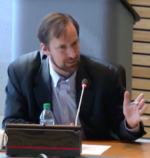 Is my program or initiative having a positive impact?
Is my program or initiative having a positive impact?
It’s a question about which organizational leaders may want hard evidence, either to take stock and help improve program results, or to satisfy their authorizers or funders who may be asking for rigorous evidence of impact. Either way, how can you determine the impact of your program? And which strategies may sound useful but are unlikely to produce accurate answers?
To examine these these questions and get a “101” on impact evaluation, we’re joined by David Evans (@tukopamoja). He is a Senior Economist at the World Bank and the co-author, with Bruce Wydick, of a recent post on the Bank’s Development Impact blog on this topic.
The interview covers:
- The concept of impact
- Ways that organization could try to estimate impact that generally won’t be accurate
- Three strategies to more accurately estimate program impact:
- Using a lottery, aka a randomized experiment
- Using an eligibility cutoff, aka regression discontinuity design
- Using before and after data for both participants and nonparticipants, aka a differences-in-differences approach
- Factors to guide the choice of one impact evaluation strategy over another